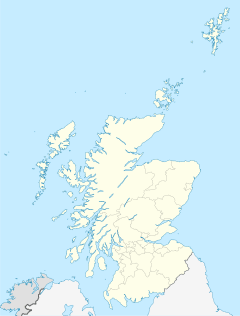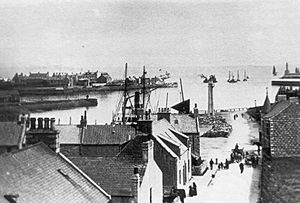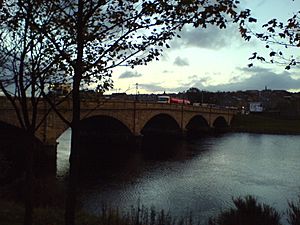Torry facts for kids
Quick facts for kids Torry
|
|
|---|---|
 Victoria Road, Torry |
|
| Population | 10,465 |
| OS grid reference | NJ952050 |
| Council area | |
| Lieutenancy area |
|
| Country | Scotland |
| Sovereign state | United Kingdom |
| Post town | ABERDEEN |
| Postcode district | AB11 |
| Dialling code | 01224 |
| Ambulance | Scottish |
| EU Parliament | Scotland |
| UK Parliament |
|
| Scottish Parliament |
|
| Website | aberdeencity.gov.uk |
Torry is an area within Aberdeen, Scotland. It's a historic place with a strong connection to the sea and fishing. Over the years, Torry has changed a lot, especially with the growth of Aberdeen Harbour and the discovery of North Sea oil.
Contents
Torry's History and Beginnings
People have lived in Torry for a very long time, since at least the 1100s. The name "Torry" first appeared in official papers in 1484. In 1495, King James IV made Torry a "Burgh of Barony." This meant it had special rights and could hold markets and fairs.
The first bridge connecting Torry to Aberdeen was built in the 1520s. Torry's first pub, called 'le Sandy Velle', opened in 1535. It served people traveling between Torry and Aberdeen.
Over time, a part of Torry known as 'Old Torry' became a busy fishing village. It was located right on the south bank of the River Dee. In 1842, the harbour built two special lights in Old Torry. These "leading lights" helped guide ships safely into Aberdeen Harbour, and they are still working today!
Some of Old Torry's oldest homes were removed in 1871. This happened when the River Dee was moved to make the harbour bigger. This change also allowed for the building of the Queen Victoria Bridge, which opened in 1881. In 1891, Torry officially became part of the City of Aberdeen.
How Oil Changed Torry
In the 1970s, a lot of oil and gas was found in the North Sea. This led to a big rush to update Aberdeen's harbour for the oil industry. A company called Shell Oil wanted to knock down Old Torry. They planned to build storage tanks for oil and gas right by the harbour.
The Aberdeen City Council agreed to these plans. Even though some people protested, the UK Government also approved the project. The homes in Old Torry were bought by the government, even if people didn't want to sell them. This is called a compulsory purchase. In 1974, Old Torry was completely demolished. Today, that area is called the 'Torry Marine Base' and is part of Aberdeen Harbour.
In 2017, some people who used to live in Old Torry raised money to put up an information board. This board helps remember the old fishing village that was once there.
Later, a new part of Torry, called New or Upper Torry, grew up the hillside. This moved the main part of modern Torry away from the river.
Life and Work in Torry
Torry is still known for its fishing community. Many fishing businesses operate near the River Dee. There's also a Fisheries Research Laboratory on Victoria Road, where scientists study fish and the sea.
Torry has traditionally been a place where homes are more affordable. This has attracted students and, more recently, people moving from other countries, especially Poland. In 2006, a Polish shop opened on Victoria Road to serve these new residents and their families.
The population of Torry in 2011 was 10,465 people.
Fun and Views
The 18-hole Balnagask golf course is on the east side of Torry. From here, you can see amazing views of the city. It's also a great spot to watch dolphins! They often visit the area where the harbour meets the sea.
Torry's Bridges
Today, three bridges connect Torry to the north side of the River Dee and the center of Aberdeen.
The Queen Victoria Bridge leads directly into the heart of Torry. It was finished in 1887. This bridge was built after a sad ferry accident in 1876, where 32 people died while returning from the Bay of Nigg. The bridge also carries water and gas pipes across the river.
To the west of the Victoria Bridge are two other bridges:
- The Queen Elizabeth Bridge, built in 1983.
- The narrow Wellington Suspension Bridge.
The Wellington Suspension Bridge was designed by Captain Samuel Brown and opened in 1831. It replaced an old ferry service. The bridge was fixed up in 1930. It was closed to cars in 1984 and to people walking in 2002. However, Aberdeen City Council engineers made it strong again, and it is now open for people to walk across.
Torry's Garden Suburb
In 1919, the local council started building homes for working-class families in Aberdeen. This greatly improved the quality of housing. The first of these new homes were built in Torry. Different plans for these houses were shown at the Art Gallery in April 1919.
The building of 500 new homes began the next year. Earth from the new roads was used to build a mound on top of a central hill. From this mound, people could get a full view of the city. The area grew steadily between 1919 and 1933. A key part of this new area was the Torry Intermediate School, which opened in 1927 with 305 students.
Important Places and Old Buildings
- Torry Battery: This was once a fort used to defend the area, especially during World War II. It is now a protected historical site. Nearby are the remains of a station that used rockets to help save people from shipwrecks. Further along the coast, you can find an old, unused foghorn and a lighthouse designed by Robert Stevenson.
- St. Fittick's Church: This church was built in 1199 and is now a ruin. You can get the key to visit it from the golf clubhouse nearby. The graveyard here has the graves of many people who died in the Wreck of the Oscar in 1813. There's even a road in Torry named Oscar Road!
- Balnagask Motte: Near North Balnagask Road, you might see the Balnagask Motte. This could be the remains of an old earthen mound that was once the base of an early wooden castle. However, no one has dug there to find out for sure.
Every September, during the "Doors Open Day" event, many buildings in Torry open to the public for free. In 2006, Tullos Primary School and the FRS Marine Laboratory participated.
Famous People from Torry
- Annie Lennox: A famous singer from the band Eurythmics.




